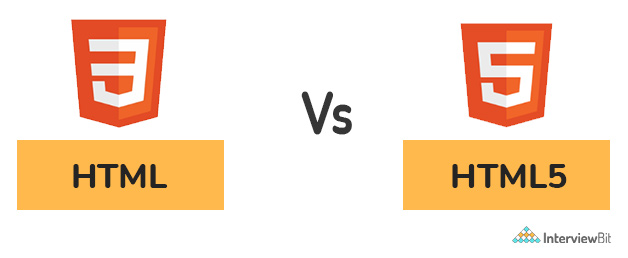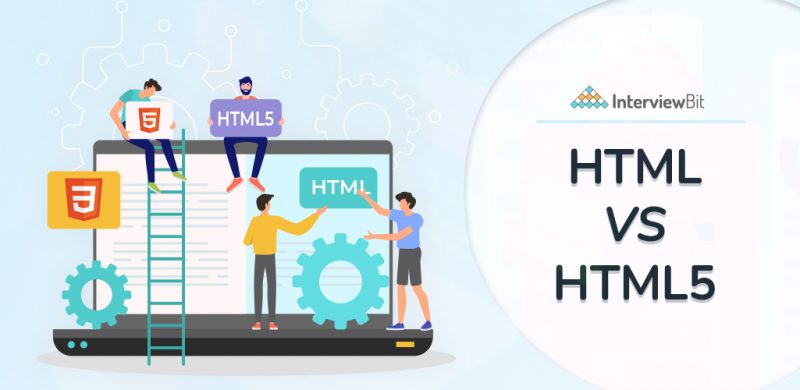- Introduction
- What is HTML?
- What is HTML5?
- Difference Between HTML and HTML5
- Conclusion
- FAQs
- Q.1: Which is better: HTML or HTML5?
- Q.2: Why do we use HTML5 instead of HTML?
- Q.3: What is the HTML5 example?
- Q.4: Can I learn HTML5 without knowing HTML?
- Q.5: Is HTML5 easy to learn?
- Q.6: Is it good to start with HTML?
- Q.7: Is HTML5 any good?
- Additional Resources
Introduction
As we know, there are a large number of languages, tools, and technologies that you can use to create a website, but HTML is one that is common to almost all websites and is one of those languages that is easier to learn and understand. HTML is short for Hypertext Markup Language. Besides providing the basic structure for all websites, HTML is also the most widely used programming language for developing web applications or websites. The latest version of HTML is HTML5 which allows better management of web applications and websites. HTML5 allows programs to incorporate any type of data, including video and audio data, while HTML5 does not support such data.
Thus before going into the differences between HTML and HTML5, we will first understand what markup language is, then we will talk about what HTML and HTML5 are. Next, we will discuss HTML vs. HTML5, how they differ, their features, which one to choose, and their advantages and disadvantages. By the end of this article, you will be able to answer these questions easily and have a clear understanding of the topic as a whole.
What is HTML?
HTML is an acronym of Hypertext Markup Language; Let’s Break up the full form and understand it word by word. Hypertext in HTML is used to represent the web pages linked together and markup language represents text documents. It’s a markup language created by Tim Berners-Lee in 1993, this was the first version of the HTML. HTML is called the language of the Web as HTML is used to create web pages and websites (collections of web pages ). We use HTML tags to define the look and feel of a website. With an understanding of tags of HTML and knowledge of how to put them together, we can create beautiful website layouts easily.
Confused about your next job?
Features of HTML
- Easy to learn and use: HTML is one of the easiest languages that you can learn and use to create web pages and static websites because of its easy-to-understand syntax and fewer requirements all you need is an editor ( Notepad, Sublime, VS code, etc ) and a browser ( google chrome, Microsoft edge, UC browser, opera, etc. )
- Platform independent: It means you can create web pages on any system, processor, or operating system and it will execute on any system that’s why it’s platform independent.
- Multimedia Support: You can add images, audio, videos along gifs to your webpage with the help of HTML.
- Interpreted language: HTML is an interpreted language that converts the code into machine language so that machines can understand it. It interprets or converts code line by line to machine language.
- Hypertexts: HTML supports hypertexts so we can add hypertexts to our web pages to interlink web pages and make a website.
Read More: HTML Features
What is HTML5?
HTML5 is also a HyperText Markup Language that is used to make web pages and websites.
So what does this 5 represent in HTML5 ? 5 in HTML5 represents that it is the 5th version of HTML and also the latest. It was introduced in 2008 by two separate groups: the World Wide Web Consortium (W3C) and the Web Hypertext Application Technology Working Group (WHATWG).
Features of HTML5
- Browser support: HTML5 has browser support. It means even if some browsers are not supporting HTML5 you will be able to load a webpage on that browser.
- Geolocation: HTML5 provides a geolocation feature. With the help of the geolocation feature, we can insert or implement maps on our web pages for example world maps, etc.
- Web storage: HTML provides two types of storage. There are two types of storages session storage( only available within the browser tab or window session ) and local storage ( localStorage is kept even between browser sessions)
- Footer: HTML5 provides a footer element The footer element is typically found at the bottom or foot of a webpage. It can contain copyright information, links to social media, and additional site navigation items.
- New Application Programming Interface (API): HTML5 features like 2D drawing on a web page, Drag and Drop, timed media playback, and browser history management.
Read More: HTML5 Features
Difference Between HTML and HTML5

We now know what HTML and HTML5 are and we have seen how they are related. Let’s see how much they differ from each other.
| Basis | HTML | HTML5 |
| Mobile friendliness | HTML is less mobile-friendly. | HTML5 is more mobile-friendly. |
| Drag and Drop feature | It does not support drag and drop effects. | It supports the drag and drops effect. |
| Media support | Does not support audio and video without the use of a flash player. | With HTML5, JavaScript runs directly on the browser through the JS Web Worker API. |
| Javascript support | The browser cannot run JavaScript directly in HTML. | Support javascript to run in background with the help of JS – web worker API |
| Vector Graphics | HTML uses vector graphics with the help of various technologies such as VML, Flash, etc. | Vector graphics are an important part of HTML5 as we use SVG and canvas in it. |
| Error Handling | HTML can not handle inaccurate syntax and any other error. Here inaccurate syntax means that the written syntax (order of tags ) is different from the original syntax. Example of basic syntax : <html> <head> <title> </title> </head> <body> </body> </html>. | HTML5 can handle inaccurate syntax and other errors. |
| 2-D shapes drawing | Shapes like circles, rectangles, triangles, etc. are not possible to draw in HTML. | Shapes like circles, rectangles, triangles, etc. are easy to draw in HTML5.’ |
| Efficiency, speed | As it’s older version, it is not fast, efficient, and flexible with respect to HTML5. | HTML5 is efficient , faster and flexible in comparison to HTML. |
| Browser support | You can run it on all old browsers without any problems. For example, Mozilla Firefox, Google Chrome, etc. | You can run it on all new browsers without any problems. For example, Mozilla Firefox version 4 to 63, Google Chrome version 61 and up, etc. |
| Memory Storage | Cookies are used by HTML to store temporary data. | Temporary data is stored in the database associated with the current webpage in HTML5. |
| Syntaxes | For document type declarations and character encoding, the syntaxes are too long and complicated. | The syntax is concise and easy to understand. |
| Substructure and semantics defining tags | HTML does not have tags that define text semantics or divide a document’s structure. | HTML5 supports tags that define text semantics or divide a document’s structure. |
| <HTML>, <Body> , and <Head> tags | It is mandatory to use these tags when writing HTML code. | It is possible to omit these tags when writing HTML code. |
| Elements | No elements like nav or header were present in HTML. | HTML5 introduces new elements for web structure such as navigation, headers, and footers. |
| Attributes | HTML lacks attributes such as charset, async, and ping. | HTML 5 includes attributes such as charset, async, and ping. |
Conclusion
We are now aware of how different HTML and HTML5 are, even though they go hand in hand. In simple terms, HTML is a hypertext markup language that is used to create web pages and websites (combination of web pages) which is introduced in the year 1993 by Tim Berners-Lee whereas HTML5 is also a hypertext markup language but it is upgraded and the latest version of HTML introduced in 2008 with some additional features like support for audio and video with the help of their specified tags and many more functionalities like enabling drag and drop feature, running javascript in background. Overall, both HTML and HTML5 are markup languages. HTML5 simply has some added features since it is an upgraded version.
FAQs
Q.1: Which is better: HTML or HTML5?
Ans: As we see in this article, HTML5 provides extra features and functionalities in comparison to HTML, and as it is the latest version of HTML it’s recommended to use HTML5 for easy and fast implementation comparison to HTML.
Q.2: Why do we use HTML5 instead of HTML?
Ans: Here are a few reasons why we use HTML5 instead of HTML. HTML5 provides you with more features with respect to the HTML such as audio, and video with the help of tags, drag and drop features, Geolocation, browser support, etc.
Q.3: What is the HTML5 example?
Ans: Here is a simple example of HTML5 where we use all heading tags:
<!DOCTYPE html> <html lang="en"> <head> <meta charset="UTF-8"> <title>Example of HTML headings tag</title> </head> <body> <h1>Heading level 1</h1> <h2>Heading level 2</h2> <h3>Heading level 3</h3> <h4>Heading level 4</h4> <h5>Heading level 5</h5> <h6>Heading level 6</h6> </body> </html>
Q.4: Can I learn HTML5 without knowing HTML?
Ans: Yes, you can as HTML5 is just an upgraded version of HTML so the concepts that you will learn in HTML5 are almost the same as HTML.
Q.5: Is HTML5 easy to learn?
Ans: HTML is one of the easiest languages to learn to develop web pages because of its simpler syntax and once you start learning it you will realize that there are no complex concepts to figure out.
Q.6: Is it good to start with HTML?
Ans: Learning HTML is the same as learning HTML5. It is just that HTML5 is the latest version of HTML with more features so it does not matter whether you start with HTML or HTML5.
Q.7: Is HTML5 any good?
Ans: Yes, HTML5 is good as it provides you with many functionalities, features, and new tags that you can use to create web pages and websites.







 Join WhatsApp Group
Join WhatsApp Group


